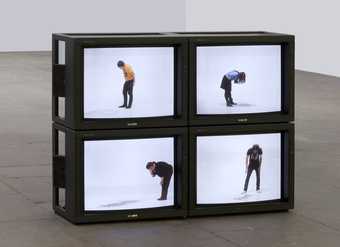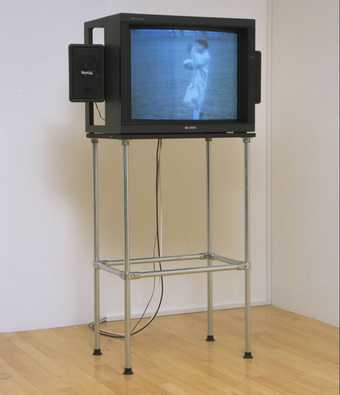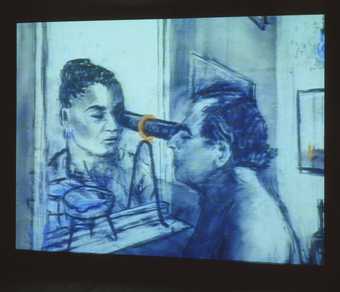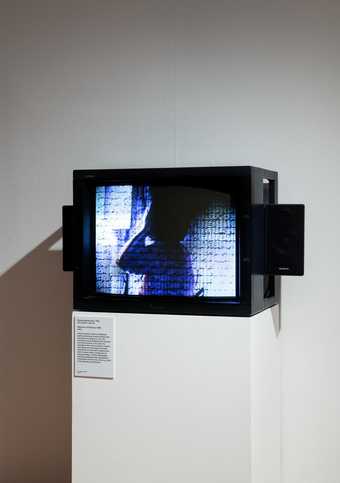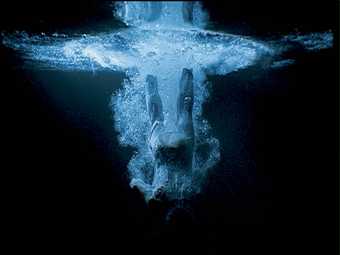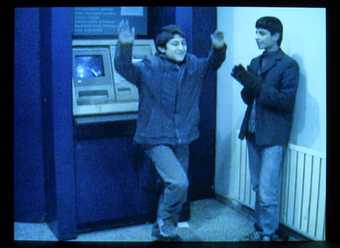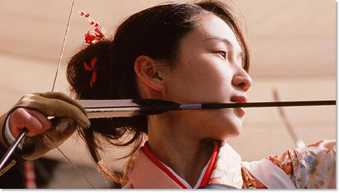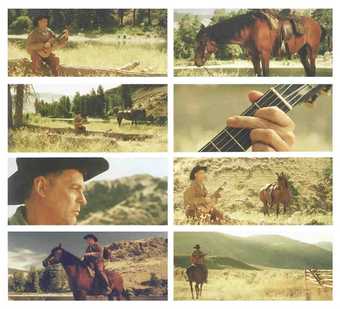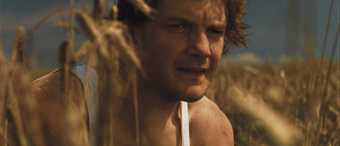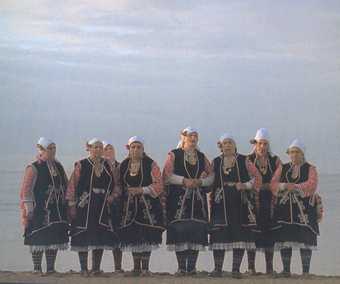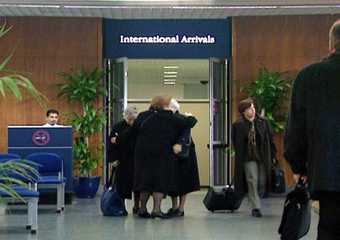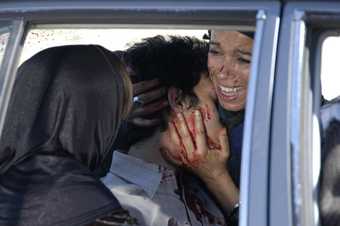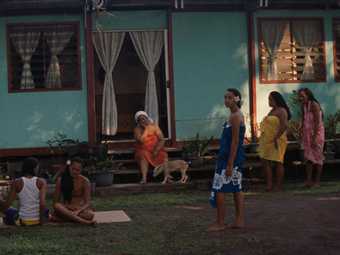Not on display
- Artist
- Shirin Neshat born 1957
- Medium
- Film, 16 mm, shown as video, 2 projections, colour and sound (stereo)
- Dimensions
- Overall display dimensions variable
duration: 15min - Collection
- Tate
- Acquisition
- Presented by the Patrons of New Art through the Tate Gallery Foundation 2003
- Reference
- T07970
Summary
Soliloquy is a double-screen colour video projection produced in an edition of six plus one artist’s proof. Tate’s copy is number six in the edition. The work was shot on 16mm film and transferred to video for editing. The two videos are projected on opposite walls, usually in an enclosed space. They depict a veiled woman, the artist herself, taking parallel journeys in two different cultural landscapes. In one video she is depicted in a middle eastern city on the edge of the desert while in the other she is in a western metropolis. For most of the seventeen and a half minute duration of the work, the action in the films alternates between the two settings. When the woman on one screen is active, walking from place to place, her counterpart in the other projection stays still, often staring directly at the camera and thus appearing to watch her alter ego on the opposite screen. At these moments her face seems to register recognition and longing.
The films are structured in parallel. Both begin with the woman looking out a window at the city below her. The woman in the middle eastern setting ventures out down cobbled streets until she reaches an ancient palace. A group of men in dark shirts and trousers and women in chadors gather and begin singing a prayer. In the modern western city the woman walks through busy streets and the atrium of a building as rush hour travellers emerge from the subway. She comes to a church. From a window in the transept she sees a group of men and women in white robes singing a Christian hymn. The soundtrack merges the music of the two groups of worshippers. Towards the end of the narrative, the two women are seen running, one into the red expanse of the desert, the other between white modernist buildings.
Neshat was born in Iran and moved to the United States to study art at the age of seventeen at the urging of her father. She began making the work for which she has become known after a return visit to Iran in 1990, her first since the 1979 revolution that brought the Ayatollah Khomeini (1902–89) to power. She was struck by the changes that had taken place in her homeland, not least the regulations insisting that women veil themselves from head to toe in the chador. The veil has become a central motif of her photographic and video work. Since the early 1990s she has travelled frequently to Iran and Soliloquy is a comment on Neshat’s experience of living between two cultures. She has said of the piece, ‘although Soliloquy was not a biographical piece, it is based on my personal experience … those of us living in a state of the “in between” have certain advantages and disadvantages. The advantage of being exposed to a new culture and in my case the freedom that comes with living in the USA. The disadvantages of course being that you will never experience again being in a “center” or quite at “home” anywhere’ (quoted in ‘Ask the Artists: Shirin Neshat’, CI:99/00, 1999, www.cmoa.org/international/html/forum/neshatresponse.htm).
The mirroring and doubling effect in Soliloquy relates to cultural critic Edward Said’s description of the state of exile. In his essay ‘Reflections on Exile’, Said (1935-2003) wrote, ‘For an exile, habits of life, expression or activity in the new environment inevitably occur against the memory of these things in another environment. Thus both the new and the old environments are vivid, actual, occurring together contrapuntally’ (quoted in Wallach, p.140). There is also a directly autobiographical element to the work’s elegiac quality. Neshat made Soliloquy soon after the deaths of both her father and her seventeen-year-old nephew. These losses made fresh her memories of leaving Iran and beginning the life of an unintentional exile.
Neshat was not able to obtain permission to film in Iran, so she and her collaborators filmed the eastern scenes of Soliloquy in Mardin in southern Turkey, seven miles from the Iranian border. The western scenes were shot mainly in Albany, New York. The sequence outside the subway station was filmed in the foyer of the World Trade Center in Manhattan.
Further reading:
Amei Wallach, ‘Shirin Neshat: Islamic Counterpoints’, Art in America, October 2001, pp.136–43, 189.
Suzanne Weaver, Concentrations: Shirin Neshat, Soliloquy, exhibition leaflet, Dallas Museum of Art, 2000.
Gerald Matt, Ruth Noack and Hamid Naficy, Shirin Neshat, exhibition catalogue, Kunsthalle Wien and Serpentine Gallery, London, 2000.
Rachel Taylor
February 2004
Does this text contain inaccurate information or language that you feel we should improve or change? We would like to hear from you.
Explore
- architecture(30,960)
-
- features(8,872)
-
- stair / step(514)
- residential(5,553)
-
- palace(467)
- formal qualities(12,454)
-
- photographic(4,673)
- contrast(176)
- actions: postures and motions(9,111)
-
- walking(607)
- woman(9,110)
- countries and continents(17,390)
-
- Turkey(41)
- USA, New York(317)
- dress: nations/regions(272)
-
- Middle East(37)
- exile(1,976)
- cultural identity(7,943)
- Iranian(2)
- gender(1,689)
You might like
-
Martin Creed Work No. 837
2007 -
Sir Steve McQueen Bear
1993 -
Lucy Gunning The Horse Impressionists
1994 -
William Kentridge Felix in Exile
1994 -
Mona Hatoum Measures of Distance
1988 -
Bill Viola Five Angels for the Millennium
2001 -
Fikret Atay Rebels of the Dance
2002 -
Fiona Tan Saint Sebastian
2001 -
Rodney Graham How I Became a Ramblin’ Man
1999 -
Jesper Just Bliss and Heaven
2004 -
Bethan Huws Singing for the Sea
1993 -
Susan Hiller Psi Girls
1999 -
Mark Wallinger Threshold to the Kingdom
2000 -
Omer Fast The Casting
2007 -
Nashashibi/Skaer Why Are You Angry?
2017


